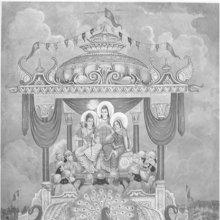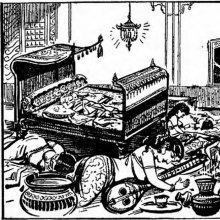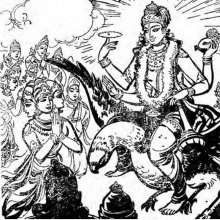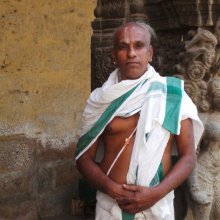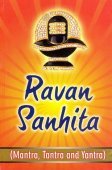Pushpaka, Puṣpaka: 21 definitions
Introduction:
Pushpaka means something in Hinduism, Sanskrit, Jainism, Prakrit, the history of ancient India, Marathi, Hindi. If you want to know the exact meaning, history, etymology or English translation of this term then check out the descriptions on this page. Add your comment or reference to a book if you want to contribute to this summary article.
The Sanskrit term Puṣpaka can be transliterated into English as Puspaka or Pushpaka, using the IAST transliteration scheme (?).
Alternative spellings of this word include Pushpak.
Images (photo gallery)
In Hinduism
Vastushastra (architecture)
Source: Wisdom Library: Vāstu-śāstra1) Puṣpaka (पुष्पक):—The Sanskrit name for one of the five Vimānas created by Brahmā, the great Creator, in the hoary past for gods. They were for travelling in the air, beautiful to look at, colossal in shape, made of gold and studded with gems. Puṣpaka was to be used by Kubera, the god of wealth. Vimānas represent the ‘aerial chariots’ of the gods, but also refers to seven-storey palaces. It is described in the 11th-century Samarāṅgaṇasūtradhāra (49.3) by Bhojadeva. Accordingly, “Puṣpaka may be square and rectangular or oblong in structure”. It is from the self-same five shapes of Vimānas that later on, Brahmā created the Prāsāda.
The Puṣpaka type of Vimāna exhibits ten different temples:
- Bhava,
- Viśāla,
- Sāmmukhya,
- Prabhava,
- Śivirāgṛha,
- Mukhaśāla,
- Dviśāla,
- Gṛharāja,
- Amala,
- Vibhu.
These are the names of 10 out of a total of 64 temples (prāsāda) mentioned in same chapter.
2) Puṣpaka (पुष्पक):—The name of a group of temple classifications, comprising 9 rectangular-shaped temple categories, according to the 8th-century Agnipurāṇa. The Puṣpaka group is one of the five groups mentioned in the purāṇa, and represents the North-Indian classification of temples.
- Valabhī,
- Gṛharāja,
- Mandira,
- Brahmamandira,
- Bhuvana,
- Prabhava,
- Śivikā,
- Śālā,
- Viśāla.
3) Puṣpaka (पुष्पक) refers to a type of temple (prāsāda) classified, according to Samarāṅgaṇasūtradhāra chapter 57. The temple is mentioned as one of the nine temples being a favorite of Bhagavatī. The Samarāṅgaṇasūtradhāra is an 11th-century encyclopedia dealing with various topics from the Vāstuśāstra.
Source: Wisdom Library: Vāstu-śāstraPuṣpaka (पुष्पक) refers to a variety of maṇḍapa (halls attached to the temple), according to the Matsya-purāṇa (verses 270.1-30). The puṣpaka-maṇḍapa is to be built with 64 pillars (stambha). The Matsyapurāṇa is one of the eighteen major purāṇas dating from the 1st-millennium BCE.
Accordingly (verse 270.15-17), “These maṇḍapas (e.g., puṣpaka) should be either made triangular, circular, octagonal or with 16 sides or they are square. They promote kingdoms, victory, longevity, sons, wife and nourishment respecitvely. Temples of other shape than these are inauspicious.”
Source: Shodhganga: Elements of Art and Architecture in the Trtiyakhanda of the Visnudharmottarapurana (vastu)Puṣpaka (पुष्पक) is classified as a “usable tree” which should be saved from being cut (for the purpose of gathering wood materials for Temple construction), according to the Viṣṇudharmottarapurāṇa, an ancient Sanskrit text which (being encyclopedic in nature) deals with a variety of cultural topics such as arts, architecture, music, grammar and astronomy.—In the Viṣṇudharmottarapurāṇa, the architect is suggested to go to the forest to collect appropriate wood for temples in an auspicious day after taking advice from an astrologer. [...] Here, the eco-friendly suggestions of Viṣṇudharmottarapurāṇa are seen to protect the greenery and to balance a pollution free environment. [...] The text gives importance in saving the usable trees and that is why the trees [viz., Puṣpaka, etc.] are advised not to be cut as these trees and their fruits are very essential for livelihood.

Vastushastra (वास्तुशास्त्र, vāstuśāstra) refers to the ancient Indian science (shastra) of architecture (vastu), dealing with topics such architecture, sculpture, town-building, fort building and various other constructions. Vastu also deals with the philosophy of the architectural relation with the cosmic universe.
Purana and Itihasa (epic history)
Source: archive.org: Puranic Encyclopedia1) Puṣpaka (पुष्पक).—A divine Aerial Chariot. Origin. Viśvakarmā had a daughter named Saṃjñā. She was married to Sūrya. But Saṃjñā could not live with Sūrya for long because of the terrible heat and so she came back and told her father about it. At once Viśvakarmā ordered Sūrya to come to him and the former then tried to reduce his brightness by rubbing him on a grindstone. However much he tried he was not able to reduce even an eighth of his brightness. The brightness of the Sun which was rubbed out spread in the atmosphere as suspended lustrous particles. Viśvakarmā collected that lustrous dust and from it created four brilliant things. The Cakrāyudha of Mahāviṣṇu is one, the Triśūla of Śiva is another, and the third is Puṣpakavimāna (Puṣpaka Aerial chariot). The fourth is Śakti, a weapon of Subrahmaṇya. Viśvakarmā gave them all as presents to Brahmā. (Chapter 2, Aṃ a 2, Viṣṇu Purāṇa). (See full article at Story of Puṣpaka from the Puranic encyclopaedia by Vettam Mani)
2) Puṣpaka (पुष्पक).—The great forest lying on one side of the mountain Latāveṣṭa situated to the south of Dvārakāpurī. (Chapter 38, Dākṣiṇātya Pāṭha, Sabhā Parva).
Source: archive.org: Shiva Purana - English Translation1) Puṣpaka (पुष्पक) refers to the chariot of Kubera, according to the Śivapurāṇa 2.2.36. Accordingly, as Brahmā narrated to Nārada:—“Indra mocked at Viṣṇu who was engrossed in his own arguments. He, the bearer of the thunderbolt, was desirous of fighting Vīrabhadra along with the other Devas. [...] Varuṇa rode on a crocodile; the wind-god rode on a deer; Kubera sat in his chariot Puṣpaka and he was ready and alert”.
2) Puṣpaka (पुष्पक) [=Puṣpa?] refers to “flowers”, according to the Śivapurāṇa 2.3.5.—Accordingly, as Brahmā narrated to Nārada the birth of Menā’s daughter:—“[...] The beloved of the mountain worshipped the Goddess along with Śiva, joyously. She gave charitable gifts always to the brahmins for their satisfaction. Desirous of obtaining a child, she worshipped Śivā everyday for twenty-seven years beginning it in the month of March-April. Observing a fast on the eighth day of the lunar fortnight, she made charitable gifts of sweets, offerings of oblation rice cakes, puddings and fragrant flowers [i.e., gandha-puṣpaka] on the ninth day. [...]”.
Source: Cologne Digital Sanskrit Dictionaries: The Purana Index1a) Puṣpaka (पुष्पक).—The aerial car in which Rāma flew to Ayodhyā;1 of Kubera;2 constructed by Śiva.3
- 1) Bhāgavata-purāṇa IX. 10. 45.
- 2) Matsya-purāṇa 174. 1-7; 191. 88; 193. 10; Vāyu-purāṇa 41. 6-7.
- 3) Matsya-purāṇa 130. 12.
1b) The maṇṭapa with 64 pillars.*
- * Matsya-purāṇa 270. 3, 7.
1c) A mountain north of the Mahābhadra;1 the residence of sages.2

The Purana (पुराण, purāṇas) refers to Sanskrit literature preserving ancient India’s vast cultural history, including historical legends, religious ceremonies, various arts and sciences. The eighteen mahapuranas total over 400,000 shlokas (metrical couplets) and date to at least several centuries BCE.
Ganapatya (worship of Ganesha)
Source: archive.org: Shiva Purana - (Ganesha)Puṣpaka (पुष्पक) refers to “flowers” (used in the worship of Gaṇeśa), according to the Śivapurāṇa 2.4.18 (“Gaṇeśa crowned as the chief of Gaṇas”).—Accordingly, as Śiva said to Gaṇeśa: “[...] He shall perform worship with the Dūrvā grass and observe fast. After a Prahara has elapsed in the night the devotee shall take bath and worship. The idol shall be made of metal, coral, white Arka flowers or clay. It shall be installed and worshipped by the devotee with all purity, with scents of various kinds, divine sandal paste and flowers (puṣpaka). [...]”.
Ganapatya (गाणपत्य, gāṇapatya) represents a tradition of Hinduism where Ganesha is revered and worshipped as the prime deity (ishta-devata). Being a minor though influential movement, Ganapatya evovled, llike Shaktism and Shaivism, as a separate movement leaving behind a large body of literature.
In Jainism
General definition (in Jainism)
Source: archive.org: TrisastisalakapurusacaritraPuṣpaka (पुष्पक) is the name of a Vimāna (celestial car), according to chapter 1.2 [ādīśvara-caritra] of Hemacandra’s 11th century Triṣaṣṭiśalākāpuruṣacaritra: an ancient Sanskrit epic poem narrating the history and legends of sixty-three illustrious persons in Jainism.
Accordingly, “[...] aroused by the sound of the bell Mahāghoṣā, the Lord of the Aiśānakalpa, carrying a trident, having a bull as a vehicle, seated in a car Puṣpaka made by the Abhiyogya Puṣpaka, descended on the south of Aiśānakalpa by an oblique path to Mt. Ratikara in the northeast of Nandīśvara and, having contracted his car like the Indra of Saudharma, quickly went, before the Blessed One on Mt. Meru with devotion.”.

Jainism is an Indian religion of Dharma whose doctrine revolves around harmlessness (ahimsa) towards every living being. The two major branches (Digambara and Svetambara) of Jainism stimulate self-control (or, shramana, ‘self-reliance’) and spiritual development through a path of peace for the soul to progess to the ultimate goal.
India history and geography
Source: Cologne Digital Sanskrit Dictionaries: Indian Epigraphical GlossaryPuṣpaka.—(CII 4), a temple. Note: puṣpaka is defined in the “Indian epigraphical glossary” as it can be found on ancient inscriptions commonly written in Sanskrit, Prakrit or Dravidian languages.

The history of India traces the identification of countries, villages, towns and other regions of India, as well as mythology, zoology, royal dynasties, rulers, tribes, local festivities and traditions and regional languages. Ancient India enjoyed religious freedom and encourages the path of Dharma, a concept common to Buddhism, Hinduism, and Jainism.
Languages of India and abroad
Marathi-English dictionary
Source: DDSA: The Molesworth Marathi and English Dictionarypuṣpaka (पुष्पक).—n S Specks or a speck on the eye, albugo. 2 or puṣpakavimāna m n The chariot of the god kubēra. Ex. tōṃ pātalā prayāṇakāḷa || vaikuṇṭhīṃhūna tayē vēḷēṃ || pu0 javaḷa || ālēṃ dāsācyā sannidha ||.
Source: DDSA: The Aryabhusan school dictionary, Marathi-Englishpuṣpaka (पुष्पक).—n Specks or a speck on the eye. puṣpaka vimāna m n The chariot of the god kubēra.
Marathi is an Indo-European language having over 70 million native speakers people in (predominantly) Maharashtra India. Marathi, like many other Indo-Aryan languages, evolved from early forms of Prakrit, which itself is a subset of Sanskrit, one of the most ancient languages of the world.
Sanskrit dictionary
Source: DDSA: The practical Sanskrit-English dictionaryPuṣpaka (पुष्पक).—
1) Flower.
2) Calx of brass.
3) A cup of iron.
4) The car of Kubera (snatched off from him by Rāvaṇa and from him by Rāma); वैमानिकाः पुण्यकृतस्त्य- जन्तु मरुतां पथि, पुष्पकालोकसंक्षोभम् (vaimānikāḥ puṇyakṛtastya- jantu marutāṃ pathi, puṣpakālokasaṃkṣobham) R.1.46;13.4.
5) A bracelet.
6) A kind of collyrium.
7) A particular disease of the eyes.
8) A bracelet of jewels.
9) A small earthen fireplace.
Derivable forms: puṣpakam (पुष्पकम्).
Source: Cologne Digital Sanskrit Dictionaries: Shabda-Sagara Sanskrit-English DictionaryPuṣpaka (पुष्पक).—n.
(-kaṃ) 1. Calx of brass used as collyrium. 2. The chariot of Kuvera. 3. A disease of the eyes, albugo, specks on the eye. 4. A bracelet of diamonds or jewels. 5. A cup or vessel of iron. 6. A small earthen fire-place or furnace. 7. Green vitriol. 8. A flower. E. kan added to the last.
Source: Cologne Digital Sanskrit Dictionaries: Benfey Sanskrit-English DictionaryPuṣpaka (पुष्पक).—[puṣpa + ka], I. m. A kind of snake, [Suśruta] 2, 265, 20. Ii. n. 1. The chariot of Kuvera, [Rāmāyaṇa] 3, 36, 15. 2. A bracelet of diamonds or jewels. 3. A cup or vessel of iron. 4. Green vitriol.
Source: Cologne Digital Sanskrit Dictionaries: Cappeller Sanskrit-English DictionaryPuṣpaka (पुष्पक).—[masculine] a kind of snake, [Name] of a mountain; [neuter] ([masculine]) [Name] of Kubera's chariot.
Source: Cologne Digital Sanskrit Dictionaries: Monier-Williams Sanskrit-English Dictionary1) Puṣpaka (पुष्पक):—[from puṣ] m. a kind of serpent, [Suśruta]
2) [v.s. ...] Name of a mountain, [Mārkaṇḍeya-purāṇa]
3) [from puṣ] n. (rarely m.) Name of the self-moving aerial car of Kubera (also -vimāna n.; it was carried off by the demon Rāvaṇa and constantly used by him till he was slain by Rāma-candra, who then employed the car to transport himself and Sītā back to Ayodhyā), [Mahābhārata; Rāmāyaṇa] etc.
4) [v.s. ...] n. Name of a forest, [Harivaṃśa]
5) [v.s. ...] calx of brass or green vitriol used as a collyrium, [cf. Lexicographers, esp. such as amarasiṃha, halāyudha, hemacandra, etc.]
6) [v.s. ...] a bracelet ([especially] one of jewels), [cf. Lexicographers, esp. such as amarasiṃha, halāyudha, hemacandra, etc.]
7) [v.s. ...] a small earthen fire-place or furnace on wheels, [cf. Lexicographers, esp. such as amarasiṃha, halāyudha, hemacandra, etc.]
8) [v.s. ...] a cup or vessel of iron, [cf. Lexicographers, esp. such as amarasiṃha, halāyudha, hemacandra, etc.]
9) [v.s. ...] a [particular] disease of the eyes (albugo), [cf. Lexicographers, esp. such as amarasiṃha, halāyudha, hemacandra, etc.]
Source: Cologne Digital Sanskrit Dictionaries: Yates Sanskrit-English DictionaryPuṣpaka (पुष्पक):—(kaṃ) 1. n. Calx of brass; car of Kuvera; albugo; a bracelet of gems; iron cup; small furnace; green vitriol; collyrium.
[Sanskrit to German]
Sanskrit, also spelled संस्कृतम् (saṃskṛtam), is an ancient language of India commonly seen as the grandmother of the Indo-European language family (even English!). Closely allied with Prakrit and Pali, Sanskrit is more exhaustive in both grammar and terms and has the most extensive collection of literature in the world, greatly surpassing its sister-languages Greek and Latin.
Hindi dictionary
Source: DDSA: A practical Hindi-English dictionaryPuṣpaka (पुष्पक) [Also spelled pushpak]:—(nm) the name of the mythological aircraft of [kubera] (the god of wealth); also —[vimāna].
...
Kannada-English dictionary
Source: Alar: Kannada-English corpusPuṣpaka (ಪುಷ್ಪಕ):—
1) [noun] = ಪುಷ್ಪ - [pushpa -] 1, 3 & 4.
2) [noun] a yellowish metal that is essentially an alloy of copper and zinc; brass.
3) [noun] a cut and polished gemstone or a pearl, used for ornamentation.
4) [noun] the light and heat of the sun; sunlight.
5) [noun] a broad, shallow kitchen vessel curved inside, used for frying.
6) [noun] a woman who has recently delivered a child.
7) [noun] a circlet worn as an ornament round the wrist.
8) [noun] (myth.) the vehicle or aircraft of Kubēra.
9) [noun] Kubēra, the regent of wealth.
10) [noun] any of the mythological aircraft of gods.
11) [noun] a chariot decorated with flowers.
12) [noun] one of the sixteen mythological mountains.
13) [noun] a particular portion of a palace.
Kannada is a Dravidian language (as opposed to the Indo-European language family) mainly spoken in the southwestern region of India.
See also (Relevant definitions)
Starts with: Pushpakala, Pushpakali, Pushpakam, Pushpakama, Pushpakami, Pushpakan, Pushpakanda, Pushpakara, Pushpakaradeva, Pushpakaranda, Pushpakarandaka, Pushpakarandini, Pushpakarandodyana, Pushpakarna, Pushpakashika, Pushpakasisa, Pushpakasisaka, Pushpakavimana.
Ends with (+35): Alpapushpaka, Amarapushpaka, Anupushpaka, Attapushpaka, Camarapushpaka, Candanapushpaka, Chamarapushpaka, Chattrapushpaka, Dadimapushpaka, Gandhapushpaka, Giripushpaka, Gucchapushpaka, Guchhapushpaka, Gudhapushpaka, Gumdipushpaka, Hemapushpaka, Jirnapushpaka, Kalayapushpaka, Kancanapushpaka, Kramukapushpaka.
Full-text (+105): Ratnavarshuka, Giripushpaka, Paushpaka, Shitapushpaka, Camarapushpaka, Pushpakam, Pushpakavimana, Mukhapushpaka, Pindapushpaka, Shonapushpaka, Talapushpaka, Vishapushpaka, Varnapushpaka, Lomashapushpaka, Gudhapushpaka, Raktapushpaka, Shvetapushpaka, Manipushpaka, Lohitapushpaka, Amarapushpaka.
Relevant text
Search found 42 books and stories containing Pushpaka, Puṣpaka, Puspaka; (plurals include: Pushpakas, Puṣpakas, Puspakas). You can also click to the full overview containing English textual excerpts. Below are direct links for the most relevant articles:
Ramayana of Valmiki (by Hari Prasad Shastri)
Chapter 41 - Rama dismisses the Pushpaka Chariot < [Book 7 - Uttara-kanda]
Chapter 124 - Bibishana places the Chariot Pushpaka at Rama’s disposal < [Book 6 - Yuddha-kanda]
Chapter 16 - The Origin of Ravana’s Name < [Book 7 - Uttara-kanda]
Puranic encyclopaedia (by Vettam Mani)
Rudra-Shiva concept (Study) (by Maumita Bhattacharjee)
2. Physical appearance of Śiva < [Chapter 5 - Rudra-Śiva in the Purāṇic Literature]
The Skanda Purana (by G. V. Tagare)
Chapter 102 - Erection of Five Palatial Shrines for Lakṣmaṇa and Others < [Section 1 - Tīrtha-māhātmya]
Chapter 123 - Greatness of Rāvaṇeśvara (Rāvaṇa-īśvara) < [Section 1 - Prabhāsa-kṣetra-māhātmya]
Chapter 101 - Installation of Rāmeśvara in the Middle of the Setu < [Section 1 - Tīrtha-māhātmya]
Samarangana-sutradhara (Summary) (by D. N. Shukla)
Vastu-shastra (1): Canons of Architecture (by D. N. Shukla)
(iv.c) Aparājitapṛcchā (Summary) < [Chapter 5 - Study of Hindu Science of Architecture]
(ii) The Site-planning (Vāstupada-vīnyāsa) < [Chapter 6 - Fundamental Canons of Hindu Architecture]
Related products
